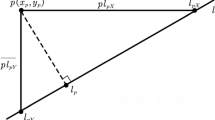Abstract
A gradient-constrained minimum network T is a minimum length network, spanning a given set of nodes N in space with edges whose gradients are all no more than an upper bound m. The nodes in T but not in N are referred to as Steiner points. Such networks occur in the underground mining industry where the typical maximal gradient is about 1:7 (≈ 0.14). Because of the gradient constraint the lengths of edges in T are measured by a special metric, called the gradient metric. An edge in T is labelled as a b-edge, or an m-edge, or an f-edge if the gradient between its endpoints is greater than, or equal to, or less than m respectively. The set of edge labels at a Steiner point is called its labelling. A Steiner point s with a given labelling is called labelled minimal if T cannot be shortened by a label-preserving perturbation of s. Furthermore, s is called locally minimal if T cannot be shortened by any perturbation of s even if its labelling is not preserved. In this paper we study the properties of labelled minimal Steiner points, as well as the necessary and sufficient conditions for Steiner points to be locally minimal. It is shown that, with the exception of one labelling, a labelled minimal Steiner point is necessarily unique with respect to its adjacent nodes, and that the locally minimal Steiner point is always unique, even though the gradient metric is not strictly convex.
Similar content being viewed by others
References
Booth R.S., Thomas D.A. and Weng J.F. (2004). Exactly Solvable and Unsolvable Shortest Network Problems in 3D-space. Contrib. Algebra Geometry 45: 649–663
Brazil M., Thomas D.A. and Weng J.F. (1998). Gradient-constrained minimal Steiner trees. DIMACS Ser. Discrete Math. Theor. Comput. Sci. 40: 23–38
Brazil M., Rubinstein J.H., Thomas D.A., Lee D., Weng J.F. and Wormald N.C. (2000). Network optimisation of underground mine design. Aust. Inst. Mining Metallurgy Proc. 305(1): 57–65
Brazil M., Rubinstein J.H., Thomas D.A., Weng J.F. and Wormald N.C. (2001). Gradient-constrained minimum networks (I). Fundamentals. J. Glob. Optim. 21: 139–155
Brazil M., Lee D., Rubinstein J.H., Thomas D.A., Weng J.F. and Wormald N.C. (2002). A network model to optimise cost in underground mine design. Trans. S. Afri. Inst. Elec. Eng. 93: 97–103
Brazil M. and Thomas D.A. (2007). Network optimisation for the design of underground mines. Networks 49: 40–50
Rubinstein J.H. and Thomas D.A. (1991). A variational approach to the Steiner network problem. Ann. Oper. Res. 33: 481–499
Rubinstein J.H., Thomas D.A. and Weng J.F. (2002). Simpson intersections and Steiner trees for four points in space. Geometriae Dedicata 93: 57–70
Weng J.F. (1985). Generalized Steiner problem and hexagonal coordinate system (in Chinese). Acta. Math. Appl. Sinica 8: 383–397
Weng, J.F.: An approach to conic sections, unpublished research note, http://www.ee.unimelb.edu.au/staff/weng/otherworks/conics2.pdf, 1998
Author information
Authors and Affiliations
Rights and permissions
About this article
Cite this article
Brazil, M., Thomas, D.A. & Weng, J.F. Gradient-constrained minimum networks (II). Labelled or locally minimal Steiner points. J Glob Optim 42, 23–37 (2008). https://doi.org/10.1007/s10898-007-9201-x
Received:
Accepted:
Published:
Issue Date:
DOI: https://doi.org/10.1007/s10898-007-9201-x




